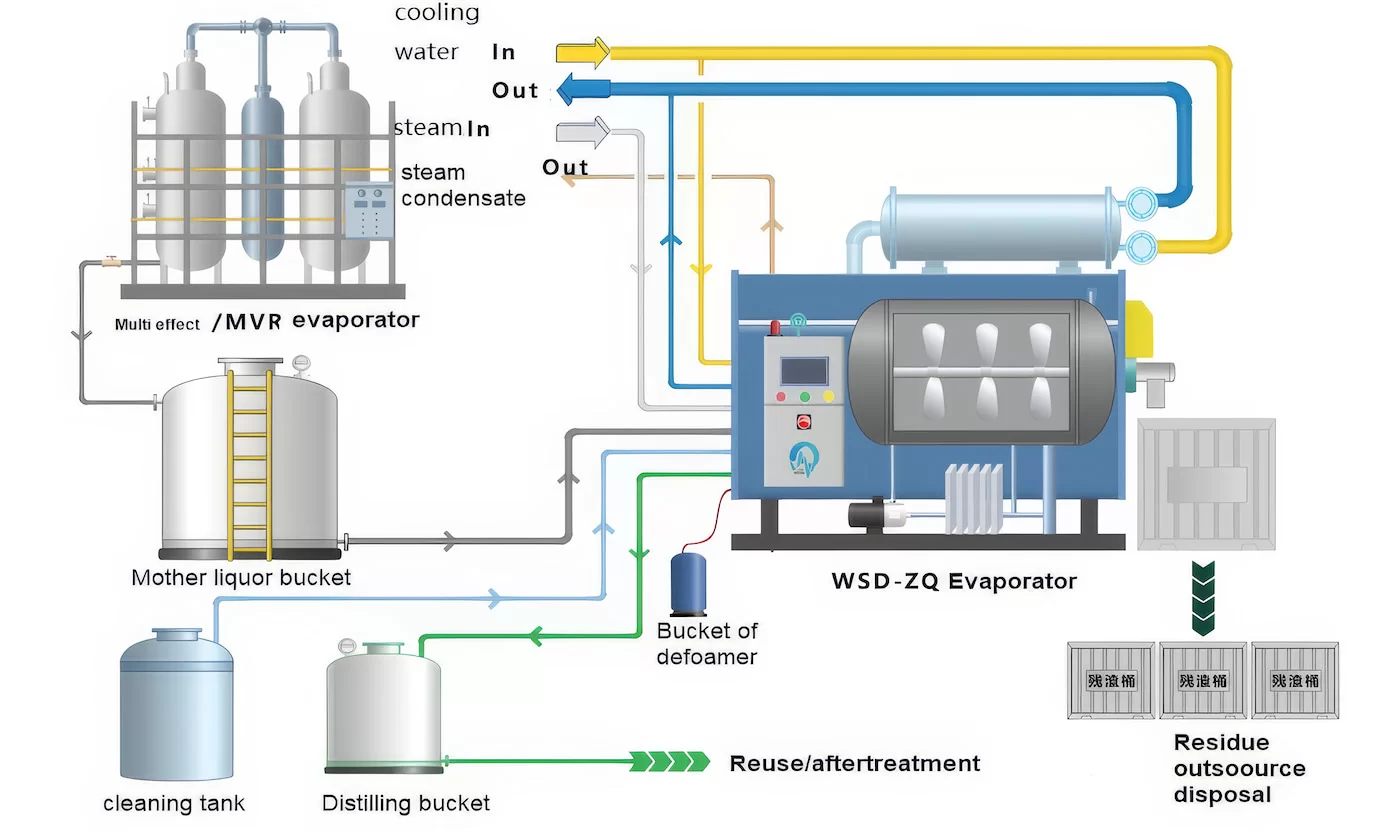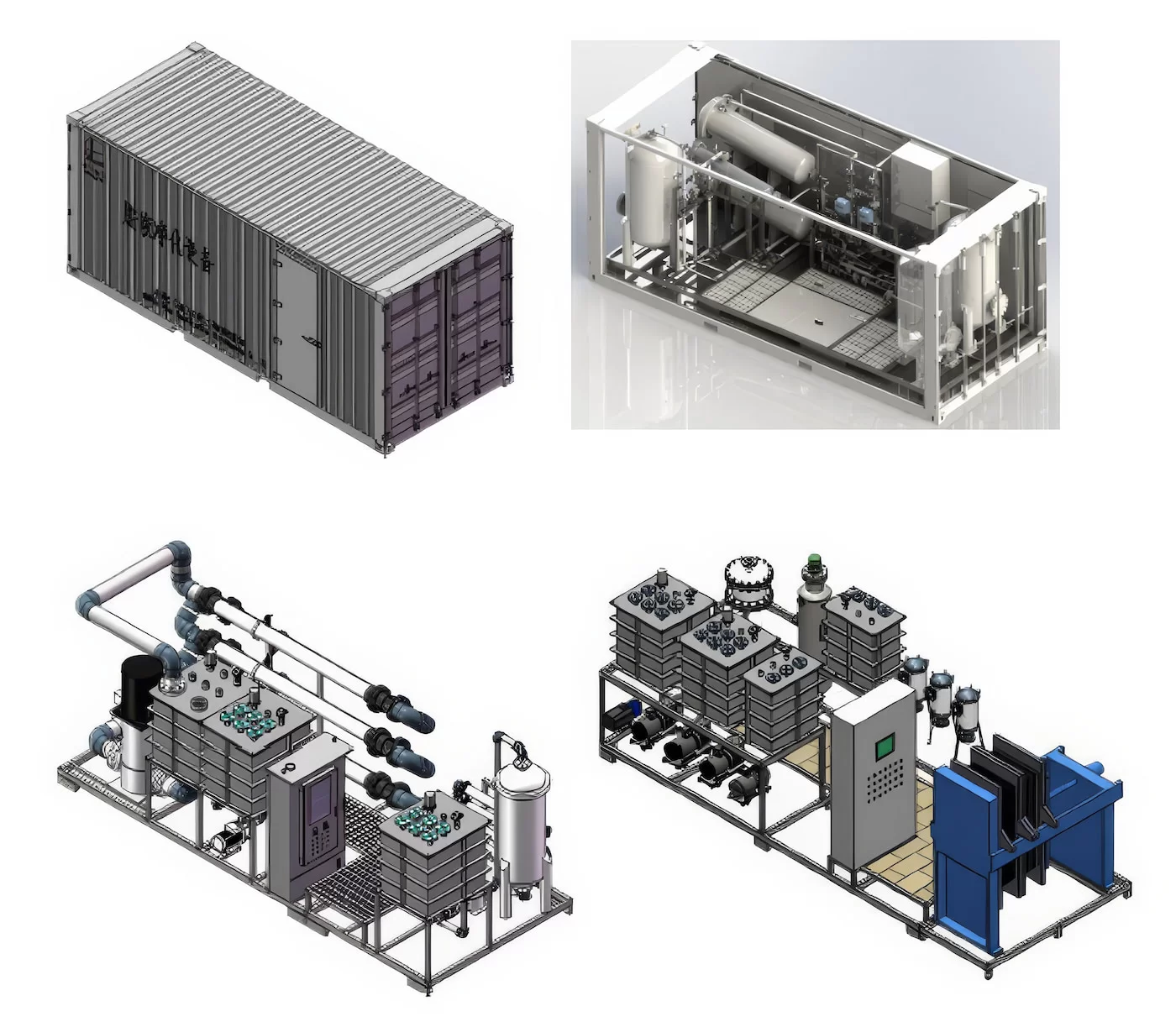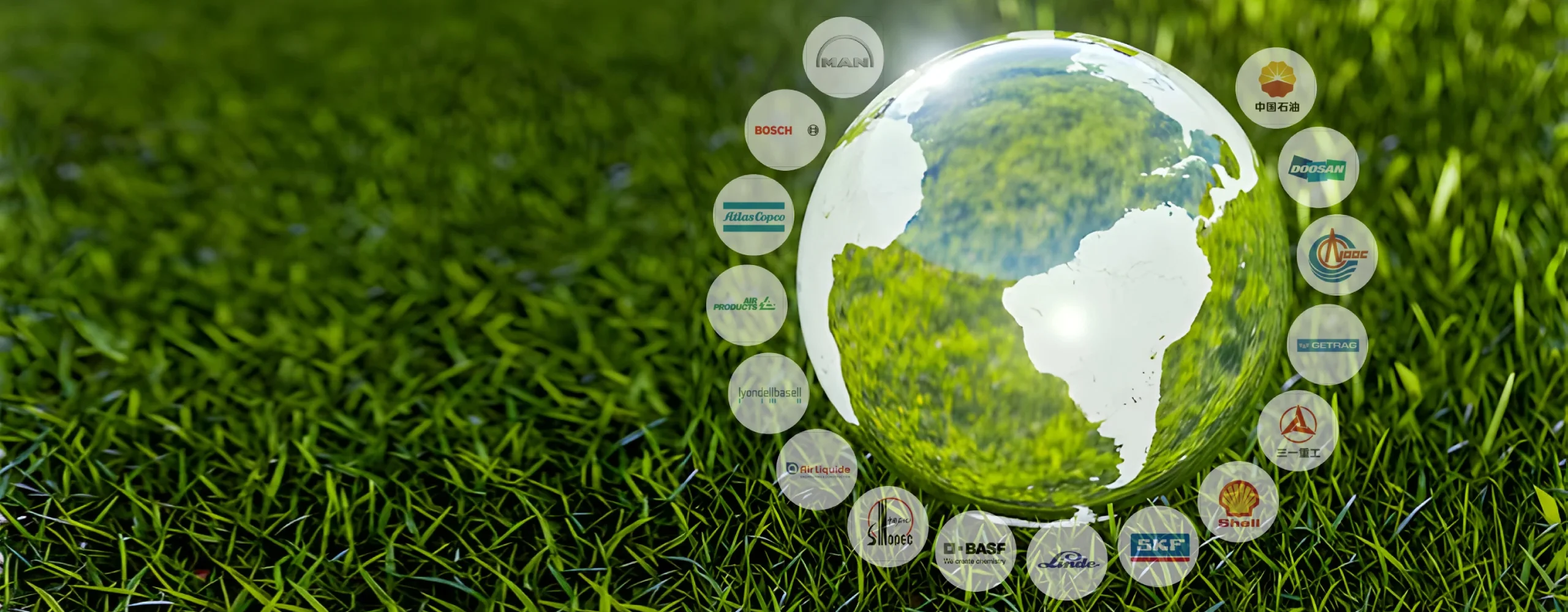Характеристика сточных вод при разработке нефтяных и газовых месторождений
| Основные ингредиенты | Характеристика | Вред |
| Полимер (коллоид) | Концентрация < 600 мг/л, молекулярная масса 1,5-6 миллионов | Повышенная вязкость пластовой воды затрудняет разделение нефти и воды. |
| Содержание масла | Концентрация 200-1000 мг/л | Блокирование пласта при закачке и загрязнение при сбросе |
| Взвешенные вещества | Концентрация 30-500 мг/л | Заблокированная формация |
| Минерализация | Концентрация 4000-60000 мг/л. Фактическая выше | Ускоренная коррозия трубопроводов |
| Микроорганизм | Железобактерии, сапрофиты, сульфатредуцирующие бактерии | Вызывает коррозию трубопроводов |
| Твердость | Концентрация 1000-20000 мг/л | Блокировка пластов и трубопроводов |
Сточные воды, образующиеся при разработке нефтяных и газовых месторождений, требуют особой очистки из-за высокой концентрации солей. Высокая концентрация солей в этих сточных водах проявляется, главным образом, в следующем:
1. Высокая минерализация: Минерализация сточных вод нефтяных и газовых месторождений обычно очень высокая, с концентрацией в диапазоне 4000–60000 мг/л, а в некоторых случаях достигает 150000 мг/л; это значительно затрудняет очистку сточных вод.
2. Содержат множество ионов: сточные воды содержат большое количество ионов Na, K, Cl, сульфатов, кальция, магния и других. Присутствие этих ионов значительно превышает допустимые нормы солесодержания сточных вод для орошения сельскохозяйственных угодий. Прямой сброс сточных вод в сточные воды может привести к серьёзному загрязнению окружающей среды.
3. Высокая концентрация органических веществ: Содержание органических веществ в сточных водах нефтегазовых месторождений очень велико, а показатель ХПК (химического потребления кислорода) может достигать тысяч или даже десятков тысяч. Эти органические вещества сохраняются после очистки обычными физико-химическими методами.
4. Микробное загрязнение: Сточные воды могут содержать такие микроорганизмы, как железобактерии, сапрофиты и сульфатредуцирующие бактерии. Эти микроорганизмы могут вызывать коррозию трубопроводов и влиять на работу очистных сооружений.
5. Высокая жесткость: Жесткость сточных вод высокая, с концентрацией от 1000 до 20000 мг/л, что может привести к закупорке пластов и трубопроводов.
6. Высокое содержание нефти: Содержание нефти в сточных водах высокое, с концентрацией от 200 до 1000 мг/л, что не только затрудняет разделение нефти и воды, но и может заблокировать пласт во время процесса обратной закачки.
7. Высокое содержание взвешенных веществ: концентрация взвешенных веществ в сточных водах составляет 50–2000 мг/л, и эти взвешенные вещества также могут блокировать пласт и влиять на нормальную эксплуатацию нефтяных и газовых месторождений.

Трудности удаления органических веществ из сточных вод с высокой соленостью при разработке нефтяных и газовых месторождений
Удаление органических веществ из высокосолёных сточных вод, образующихся при разработке нефтяных и газовых месторождений, сопряжено с рядом трудностей. Эти трудности обусловлены, главным образом, высокой соленостью, сложным составом и ограничениями технологий очистки сточных вод. Ниже представлен подробный анализ этих трудностей:
1. Влияние высокой солености на удаление органических веществ
Подавление микробной активности: Высокая соленость сточных вод значительно подавляет рост и активность микроорганизмов, тем самым снижая эффективность биологической очистки. Микроорганизмы очень чувствительны к изменению солености окружающей среды. Высокая соленость может вызвать обезвоживание или даже гибель микробных клеток, что делает невозможным эффективное разложение органических веществ в сточных водах.
Увеличение затрат на очистку: Для снижения солености сточных вод обычно требуется их разбавление, что увеличивает расход воды и стоимость очистки. Кроме того, высокая соленость может привести к коррозии и повреждению очистного оборудования, что дополнительно увеличивает расходы на обслуживание и замену оборудования.
2.Сложность состава сточных вод
Различные типы органических веществ: сточные воды нефтегазовых месторождений содержат разнообразные органические вещества, включая углеводороды, фенолы, спирты, альдегиды и т. д. Химические свойства и биоразлагаемость этих органических веществ различны, что затрудняет их удаление.
Неорганические соли и другие примеси: Помимо высокой солености, сточные воды также содержат большое количество неорганических солей, ионов тяжелых металлов, взвешенных веществ и других примесей. Эти примеси образуют комплексные соединения с органическими веществами, что еще больше снижает их разлагаемость.
3.Ограничения технологии обработки
Ограничения биологической очистки: Несмотря на то, что биологическая очистка, как уже упоминалось, обладает такими преимуществами, как низкая стоимость и высокая эффективность очистки сточных вод, высокая соленость воды значительно подавляет активность микроорганизмов, что ограничивает ее применение. Кроме того, системы биологической очистки плохо адаптируются к колебаниям качества воды и изменениям окружающей среды и легко подвергаются воздействию внешних факторов, что приводит к снижению эффективности очистки.
Проблемы физико-химической очистки: Хотя физико-химические методы, такие как выпаривание, электролиз и ионный обмен, позволяют удалять соли и органические вещества из сточных вод, они обычно сталкиваются с такими проблемами, как высокая стоимость, высокое энергопотребление и лёгкое вторичное загрязнение. Особенно при удалении органических веществ из сточных вод с высокой соленостью эти методы часто не достигают желаемого эффекта.
4.Решения и будущие направления
Предварительная очистка и разбавление: удаление примесей, таких как взвешенные вещества и ионы тяжелых металлов, из сточных вод с помощью предварительной очистки, а также надлежащее разбавление сточных вод для снижения солености, создавая благоприятные условия для последующей очистки.
Оптимизация процесса биологической очистки: отбор и окультуривание штаммов микроорганизмов, способных расти в условиях высокой солености, для повышения адаптивности и эффективности методов биологической очистки. Также можно рассмотреть возможность комбинирования нескольких процессов биологической очистки, например, комбинированной аэробно-анаэробной очистки.
Инновационная технология физико-химической очистки: разработка новых высокоэффективных, энергосберегающих и экологически чистых технологий физико-химической очистки, таких как передовая технология окисления и технология мембранного разделения, для повышения эффективности удаления органических веществ и снижения затрат на очистку.
Использование ресурсов: изучение способов использования солей и органических веществ в сточных водах нефтяных и газовых месторождений, таких как извлечение солевых ресурсов путем выпаривания и кристаллизации, а также преобразование органических веществ в ценные химические вещества или энергетические вещества путем биологического или химического преобразования.
Решения по удалению органических веществ из сточных вод с высокой соленостью при разработке нефтяных и газовых месторождений
Решение проблемы удаления органических веществ из высокосолёных сточных вод, образующихся при разработке нефтяных и газовых месторождений, можно рассматривать комплексно, учитывая различные аспекты, включая предварительную очистку, биологическую очистку, физико-химическую очистку и стратегии использования ресурсов. Ниже приведены некоторые конкретные решения:
1. Предварительная обработка
Удаление взвешенных веществ и тяжелых металлов: удаление взвешенных веществ, крупных частиц примесей и ионов тяжелых металлов из сточных вод с помощью физических методов (таких как осаждение и фильтрация) для снижения помех последующим процессам очистки.
Регулировка значения pH: Регулировка значения pH сточных вод до диапазона, подходящего для последующих процессов очистки, поможет улучшить эффект очистки.
Разбавление: При необходимости сточные воды с высокой соленостью можно разбавить путем добавления пресной воды или других сточных вод с низкой соленостью для снижения их солености, но следует тщательно контролировать степень разбавления, чтобы избежать чрезмерного увеличения затрат на очистку.
2. Биологическая очистка
Скрининг и одомашнивание солеустойчивых микроорганизмов: скрининг и одомашнивание штаммов микроорганизмов, способных расти в условиях высокой солености. Эти штаммы обладают высокой способностью к разложению органических веществ и могут эффективно удалять органические вещества из сточных вод в условиях высокой солености.
Проектирование биореактора: проектирование биореакторов, подходящих для очистки сточных вод с высокой соленостью, например, с использованием анаэробно-аэробных комбинированных процессов очистки для повышения эффективности биодеградации.
Добавление биоусилителей: добавление биоусилителей, таких как ферментные препараты, микробные агенты и т. д., в систему биологической очистки для ускорения процесса разложения органических веществ.
3. Физико-химическая обработка
Передовая технология окисления: использование озона, реагента Фентона, ультрафиолетового света и других передовых технологий окисления для получения сильных окислительных свободных радикалов, окисления и разложения трудноразлагаемых органических веществ в сточных водах на мелкие молекулы и даже минерализации на углекислый газ и воду.
Технология мембранного разделения: ультрафильтрация, нанофильтрация, обратный осмос и другие технологии мембранного разделения позволяют отделить органические вещества и соли из сточных вод благодаря селективной проницаемости мембраны. Эти технологии очень эффективны для удаления органических веществ и солей из сточных вод с высоким содержанием солей, но они дороги и подходят для случаев с высокими требованиями к качеству очищенной воды.
Адсорбция и ионный обмен: использование активированного угля, смол и других адсорбентов или ионообменных смол для удаления органических веществ и специфических ионов из сточных вод. Этот метод подходит для сточных вод с небольшим объёмом очистки или высокой концентрацией органических веществ.
4. Использование ресурсов
Выпаривание и кристаллизация для извлечения солей: соль из сточных вод концентрируется и извлекается посредством процесса выпаривания и кристаллизации для получения промышленной соли или использования в других областях. Это позволяет не только снизить содержание солей в сточных водах, но и обеспечить повторное использование ресурсов.
Переработка и утилизация органических веществ: исследование процесса переработки органических веществ из сточных вод в ценные химические вещества или энергетические вещества (например, биодизель, водород и т. д.) с помощью технологий биологической или химической переработки. Этот метод позволяет не только удалять органические вещества из сточных вод, но и использовать ресурсы отходов.
5. Комплексное лечение
Комбинация нескольких процессов: в соответствии со специфическими характеристиками и требованиями к очистке сточных вод, вышеупомянутые многопроцессные процессы очистки комбинируются и оптимизируются для формирования комплексного плана очистки. Например, взвешенные вещества и ионы тяжёлых металлов могут быть удалены предварительной очисткой, затем большая часть органических веществ может быть удалена биологической очисткой, и, наконец, качество воды может быть дополнительно улучшено физико-химической очисткой.
6. Интеллектуальное управление: Внедрение интеллектуальной системы управления для мониторинга и контроля процесса очистки сточных вод в режиме реального времени для обеспечения стабильных и надежных результатов очистки и снижения эксплуатационных расходов.

Каковы преимущества и недостатки технологии очистки сточных вод с высоким содержанием солей?
Преимущества и недостатки технология очистки сточных вод с высоким содержанием солей Различаются в зависимости от конкретных технических методов. Ниже представлен обзор преимуществ и недостатков некоторых распространённых технологий очистки сточных вод с высоким содержанием солей:
1.Метод испарения и кристаллизации
Преимущества:
Высокая скорость опреснения: благодаря процессу испарения соль в сточных водах может быть высококонцентрирована и кристаллизована для эффективного удаления солей. Кратность концентрации «теоретически» неограниченна.
Хороший эффект очистки: позволяет значительно снизить содержание солей в сточных водах, а качество воды после очистки относительно стабильно.
Рекуперация ресурсов: Кристаллизованная соль может быть переработана как побочный продукт и имеет определенную экономическую ценность.
Недостатки:
Высокое потребление энергии: процесс испарения требует большого количества тепловой энергии, что приводит к высокому потреблению энергии.
Сложное оборудование и высокие инвестиции: Оборудование для выпаривания и кристаллизации относительно сложное и требует профессиональной эксплуатации и обслуживания.
Высокие эксплуатационные расходы: из-за таких факторов, как потребление энергии и техническое обслуживание оборудования, эксплуатационные расходы относительно высоки.
2.Метод мембранной очистки (например, обратный осмос, нанофильтрация)
Преимущества:
Эффективное удаление солей: Метод мембранной очистки обеспечивает высокую скорость опреснения и позволяет эффективно удалять соли из сточных вод.
Высокое качество воды: очищенная вода прозрачна и пригодна для повторного использования или дальнейшей очистки.
Компактность: оборудование для мембранной очистки сравнительно компактно и занимает небольшую площадь.
Недостатки:
Высокое энергопотребление: особенно для сточных вод с высокой концентрацией солей, для обеспечения достаточного давления требуется насос высокого давления, что потребляет много энергии.
Загрязнение мембраны: После длительного использования мембрана легко загрязняется и ее необходимо регулярно чистить или заменять, что увеличивает затраты на обслуживание.
Высокая стоимость оборудования: первоначальные инвестиционные затраты на оборудование мембранной очистки высоки.
3. Метод ионного обмена
Преимущества:
Эффективное удаление солей: ионообменная смола способна избирательно удалять соли и другие ионы из сточных вод.
Зрелый процесс: Технология ионного обмена относительно зрелая и простая в эксплуатации.
Недостатки:
Высокая стоимость регенерации смолы: для сточных вод с высокой концентрацией солей требуется частая регенерация или замена смолы, что увеличивает стоимость очистки.
Очистка жидких отходов: жидкие отходы, образующиеся в процессе регенерации смолы, необходимо правильно утилизировать, чтобы избежать вторичного загрязнения.
4.Биологический метод очистки
Преимущества:
Экологичность: Биологическая очистка использует метаболизм микроорганизмов для разложения органических веществ и солей в сточных водах без добавления химических реагентов.
Низкие эксплуатационные расходы: по сравнению с другими физическими и химическими методами эксплуатационные расходы биологической очистки ниже.
Недостатки:
Эффективность очистки во многом зависит от качества воды: биологическая очистка предъявляет высокие требования к качеству воды и во многом зависит от таких факторов, как тип, концентрация и соленость органических веществ в сточных водах.
Длительный цикл очистки: Биологическая очистка обычно требует длительного цикла очистки для достижения идеального эффекта очистки и не может удовлетворить требованиям быстрого сброса, быстрой очистки и своевременного сбраживания «сточных вод нефтегазовых месторождений».
Какие законы и правила по охране окружающей среды необходимо соблюдать при очистке сточных вод с высоким содержанием солей?
При очистке сточных вод с высоким содержанием солей необходимо соблюдать следующие основные законы и правила по охране окружающей среды:
1. «Закон Китайской Народной Республики об охране окружающей среды»: являясь основным законом страны об охране окружающей среды, он определяет обязанности предприятий по охране окружающей среды в процессе освоения ресурсов, требует принятия эффективных мер по сокращению загрязнения окружающей среды и экологического ущерба, усиления мер по предотвращению экологических рисков и содействия технологическому прогрессу.
2. «Закон Китайской Народной Республики о предотвращении и контроле загрязнения вод»: устанавливает требования по защите водной среды, включая стандарты сброса сточных вод и меры по предотвращению и контролю загрязнения, в целях предотвращения загрязнения вод, защиты и улучшения качества окружающей среды.
3. «Комплексный стандарт сброса сточных вод» (GB8978-1996): устанавливает национальные стандарты сброса сточных вод, включая предельные концентрации различных загрязняющих веществ в сточных водах, гарантируя, что сточные воды могут быть сброшены только после очистки в соответствии с установленными стандартами.
4. «Техническая политика по предотвращению и контролю загрязнения в нефтяной и газовой промышленности»: издана Министерством экологии и окружающей среды и содержит конкретные рекомендации по технической политике, включая чистое производство, экологическую защиту, контроль загрязнения, новые технологии, поощряемые для исследований и разработок, а также управление операциями и предотвращение рисков.
5. «Технические условия на очистку сточных вод нефтедобычи» (HJ 2041-2014): устанавливает технические требования к проектированию, строительству, приемке и управлению эксплуатацией объектов очистки сточных вод нефтедобычи и является руководящим документом.
6. «Техническое руководство по очистке сточных вод с высоким содержанием солей органического происхождения» (проект для комментариев): Хотя это проект для комментариев, он содержит технические рекомендации по очистке сточных вод с высоким содержанием солей органического происхождения, включая технические требования к проектированию, строительству, эксплуатации и техническому обслуживанию.
Соблюдение этих правил является важной гарантией соответствия очистки сточных вод с высоким содержанием солей требованиям охраны окружающей среды, предотвращения загрязнения окружающей среды и нанесения экологического ущерба. В то же время, в процессе очистки сточных вод предприятиям следует учитывать конкретные правила и рекомендации, издаваемые местными органами охраны окружающей среды, чтобы гарантировать соответствие процесса очистки сточных вод и получаемых результатов требованиям законодательства и нормативных актов.
